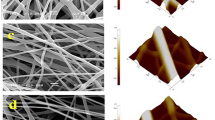Abstract
Nanofibres can be processed into several high-end applications due to their unique characteristics, especially when based on a diversity of polymers with specific properties. This, however, requires that the nanofibrous structures are produced in a highly reproducible way. The article gives focus to polyamide (PA) 6.9, a less exploited PA though with interesting properties such as a very low moisture absorption. To trace and understand the dominant parameters that allow for the aimed reproducible characteristics, the influence of the solution parameters on the steady state behaviour during electrospinning as well as the resultant fibre morphology is followed by scanning electron microscopy and differential scanning calorimetry. Results show a significant effect of the amount of non-solvent acetic acid, added to the solvent formic acid, on the steady state behaviour and the fibre morphology. The non-solvent acetic acid broadens the steady state window by making the electrospin solutions more suitable to obtain uniform and reproducible nanofibrous structures with a narrow nanofibre diameter distribution. The mixture of the solvent formic acid and the non-solvent acetic acid strongly contributes to the future potentials of PA 6.9 nanofibres, with its leading to a smaller fibre distribution and moreover highly reproducible in time.





Similar content being viewed by others
References
Ramakrishna S et al (2005) An introduction to electrospinning and nanofibres. World Scientific publishing, Singapore
Ahn YC et al (2006) Curr Appl Phys 6:1030
Bergshoef MM, Vancso GJ (1999) Adv Mater 11:1362
Neppalli R et al (2010) Eur Polym J 46(5):968
Scampicchio M et al (2010) Electroanalysis 22(10):1056
Honarbakhsh S, Pourdeyhimi B (2011) J Mater Sci 46(9):2874. doi:10.1007/s10853-010-5161-5
Ba Linh NT, Lee K-H, Lee B-T (2011) J Mater Sci 46(17):5615. doi:10.1007/s10853-011-5511-y
Zhang HT et al (2010) J Mater Sci 45:2296. doi:10.1007/s10853-009-4191-3
Huang Z-M et al (2003) Compos Sci Technol 63:2223
Van der Schueren L et al (2011) Eur Polym J 47:1256
Agarwal S et al (2008) Polymer 49(26):5603
Heikkila P, Harlin A (2008) Eur Polym J 44(10):3067
Kang H-K et al (2010) Macromol Res 19(4):364
Van der Schueren L et al (2010) Eur Polym J 46(12):2229
Havel M et al (2008) Adv Funct Mater 18(16):2322
Dhanalakslimi M, Jog JP (2008) Exp Polym Lett 2(8):540
Behler K, Havel M, Gogotsi Y (2007) Polymer 48(22):6617
Stephens JS, Chase DB, Rabolt JF (2004) Macromolecules 37:877
De Schoenmaker B et al (2011) J Appl Polym Sci 120:305
Tan S-H et al (2005) Polymer 46:6128
De Vrieze S (2009) J Appl Polym Sci 115:837
De Vrieze S et al (2011) J Appl Polym Sci 119:2984
Spivak AE, Dzcnis YA, Reneker DH (2000) Mech Res Commun 27:37
Ren ZF et al (2010) J Text Inst 101:571
Helgeson ME et al (2008) Polymer 49:2924
Kim G et al (2006) Eur Polym J 42(9):2031
Fong H et al (1999) Polymer 40(16):4585
Odian G (2004) Principles of polymerization. Wiley, New York
Wei W et al (2010) J Appl Polym Sci 118:3005
John D (1998) Lange’s handbook of chemistry and physics, 15th edn. McGraw-Hill, New York
Supaphol P et al (2005) Macromol Mater Eng 290:933
Author information
Authors and Affiliations
Corresponding author
Rights and permissions
About this article
Cite this article
De Schoenmaker, B., Goethals, A., Van der Schueren, L. et al. Polyamide 6.9 nanofibres electrospun under steady state conditions from a solvent/non-solvent solution. J Mater Sci 47, 4118–4126 (2012). https://doi.org/10.1007/s10853-012-6266-9
Received:
Accepted:
Published:
Issue Date:
DOI: https://doi.org/10.1007/s10853-012-6266-9




